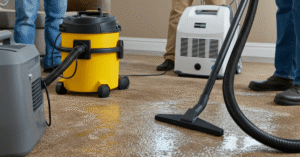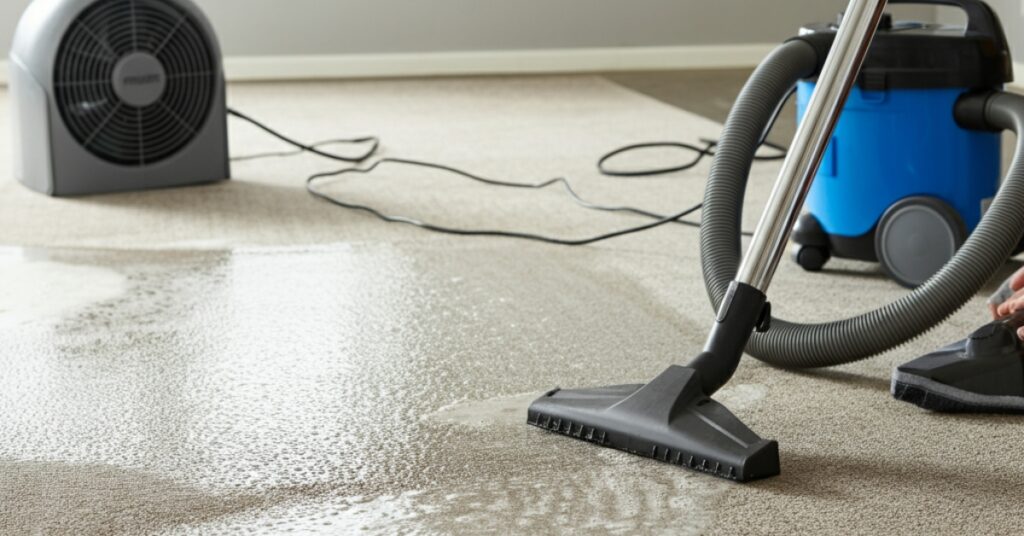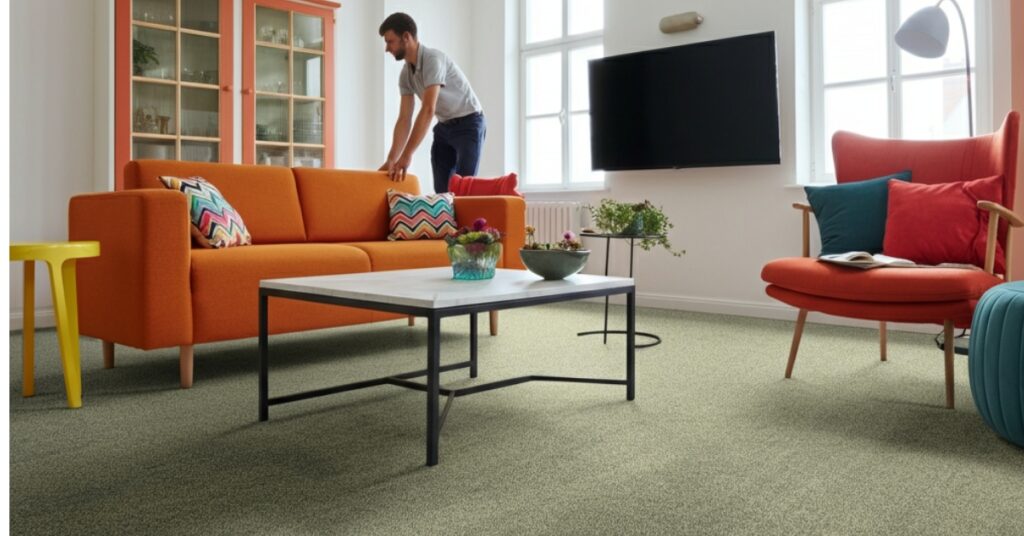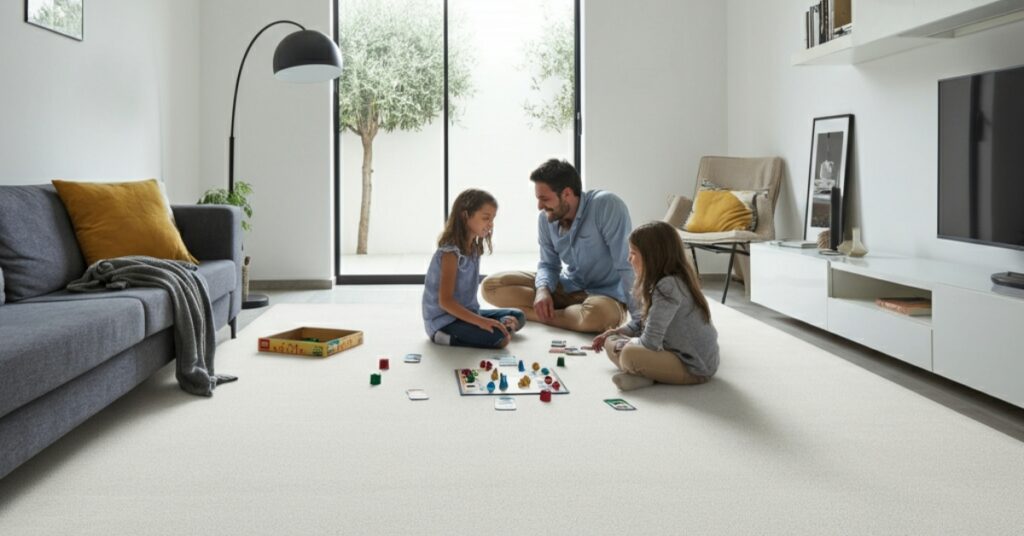As an Amazon Associate, I earn from qualifying purchases.
Dealing with a wet carpet not drying can quickly turn from a minor inconvenience into a costly nightmare. Whether it’s from a burst pipe, flooding, or a simple spill that got out of hand, standing water in your carpet creates the perfect breeding ground for mold, bacteria, and unpleasant odors.
The key to preventing long-term damage lies in acting fast. Every hour that passes increases your risk of permanent damage to both your carpet and the underlying structure of your home. Mold can begin growing within 24-48 hours, while bacteria and allergens multiply rapidly in moist environments.
This comprehensive guide will walk you through proven methods to dry your wet carpet effectively, prevent future moisture problems, and protect your home from water damage. You’ll learn the exact steps professionals use, discover the best tools for the job, and understand when it’s time to call in expert help.
Why a Wet Carpet Is a Serious Problem
A saturated carpet poses several immediate and long-term risks that extend far beyond surface-level dampness. Understanding these dangers helps explain why quick action is absolutely critical.
Mold and Mildew Growth
Mold spores are naturally present in most indoor environments, but they remain dormant until moisture activates them. Once your carpet stays wet for more than 24 hours, these spores begin multiplying exponentially. Furthermore, carpet fibers and padding provide the organic material mold needs to thrive.
Black mold, in particular, can develop rapidly in wet conditions and release toxic compounds into your air. Additionally, even seemingly harmless mold varieties can trigger respiratory issues and allergic reactions in sensitive individuals.
Damage to Flooring and Subfloor
Water doesn’t stop at carpet level—it seeps through padding and reaches your subfloor. Consequently, wood subflooring can warp, buckle, or develop rot when exposed to prolonged moisture. Similarly, concrete floors can develop cracks and structural weaknesses from repeated wet-dry cycles.
The carpet padding acts like a sponge, holding water against the subfloor for extended periods. As a result, what starts as a surface problem quickly becomes a structural issue requiring expensive repairs.
Health Risks from Allergens and Bacteria
Stagnant water creates ideal conditions for harmful bacteria growth. Moreover, dust mites multiply rapidly in humid environments, producing allergens that can trigger asthma attacks and other respiratory problems.
Children and elderly family members face particularly high risks from contaminated air quality. Therefore, addressing moisture issues becomes a health priority, not just a maintenance concern.
Lingering Odors and Air Quality Issues
Wet carpets develop musty, unpleasant odors that permeate your entire living space. These smells often persist long after the carpet appears dry because moisture remains trapped in deeper layers and padding.
Poor air quality affects your comfort and can decrease your home’s value. Prospective buyers can often detect previous water damage through lingering odors, even after professional cleaning attempts.
How to Fix a Wet Carpet That’s Not Drying (Step-by-Step)
Taking systematic action gives you the best chance of saving your carpet and preventing extensive damage. Follow these steps in order for maximum effectiveness.
Step 1: Identify and Stop the Source of Moisture
Before addressing the wet carpet itself, you must eliminate the source of water. Check for burst pipes, leaking appliances, or roof damage that continues adding moisture to the area.
Turn off water supply valves if plumbing issues are involved. Additionally, document the damage with photos for insurance purposes before beginning cleanup efforts.
Step 2: Remove Excess Water Immediately

Use a wet/dry vacuum to extract as much standing water as possible. Work in overlapping sections, making multiple passes to pull water from deep within carpet fibers.
For areas without electrical access, use clean towels to blot moisture. Press firmly and replace towels frequently as they become saturated. Never use a standard household vacuum on wet carpet, as this can cause electrical damage or personal injury.
Step 3: Improve Air Circulation Throughout the Space
Open windows and doors to create cross-ventilation whenever outdoor conditions permit. Position high-powered fans to blow air across the carpet surface, which accelerates evaporation.
Set your HVAC system to continuously circulate air rather than cycling on and off. This maintains consistent airflow and helps distribute dry air throughout affected areas.
Step 4: Deploy Dehumidifiers Strategically
Place dehumidifiers in the center of affected rooms, ensuring adequate space around each unit for proper air circulation. Empty collection tanks frequently and monitor humidity levels with a hygrometer.
Maintain indoor humidity below 50% to prevent mold growth. Run dehumidifiers continuously until moisture readings return to normal levels throughout the space.
Step 5: Lift Carpet Sections When Necessary
If water has thoroughly soaked the carpet, carefully pull back sections to expose the padding underneath. Use a utility knife to cut carpet seams if needed, but mark cutting locations for proper reinstallation.
Lifting carpet allows air to reach both sides of the material and reveals the true extent of moisture penetration. This step is particularly crucial for thick carpets or those installed over concrete floors.
Step 6: Assess Padding and Subfloor Conditions
Check carpet padding for saturation—if it feels spongy or releases water when pressed, it likely needs replacement. Wet padding rarely dries completely and often develops permanent odor problems.
Examine the subfloor for signs of water damage, including discoloration, soft spots, or visible moisture. Use a moisture meter to get accurate readings of water content in wooden subflooring materials.
Best Tools & Products to Speed Up Drying
Professional-grade equipment makes the difference between successful carpet restoration and costly replacement. Investing in or renting the right tools pays for itself through prevented damage.
Wet/Dry Vacuum Systems
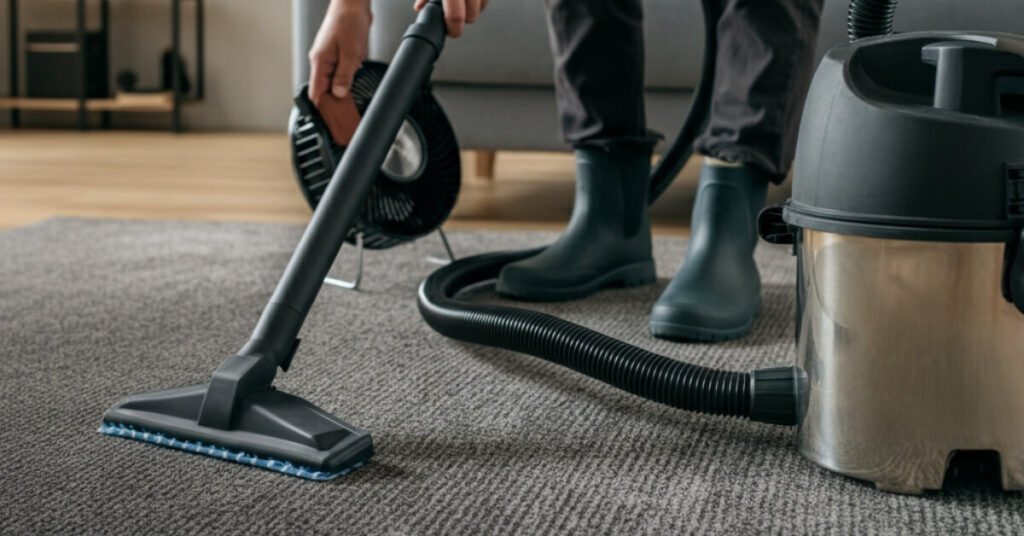
Heavy-duty shop vacuums with powerful suction capabilities remove significantly more water than standard home units. Look for models with large tank capacities to minimize emptying frequency during extended extraction sessions.
Some wet vacuums include specialized carpet attachments that create better seals against carpet surfaces. These attachments improve suction efficiency and reduce the physical effort required for thorough water removal.
High-Powered Fans and Air Movers
Commercial air movers move substantially more air than household fans, creating the strong airflow necessary for rapid drying. Position multiple units to create air circulation patterns that reach all affected areas.
Centrifugal air movers work particularly well for carpet drying because they produce focused, high-velocity airflow. Axial fans cover larger areas but with less concentrated air movement.
Professional-Grade Dehumidifiers
Refrigerant dehumidifiers excel in moderate temperature conditions and remove large volumes of moisture from the air. Desiccant dehumidifiers work better in cooler environments and continue operating effectively at lower temperatures.
Calculate the square footage of affected areas to determine appropriate dehumidifier capacity. Undersized units struggle to keep up with moisture production, while oversized units waste energy and may overcool the space.
Specialized Carpet Dryers
Carpet drying mats slip under lifted carpet sections, injecting heated air directly into the padding and subfloor area. This targeted approach dramatically reduces drying time compared to surface-only methods.
Injectidry systems use flexible tubing to deliver heated air to specific locations under carpet and padding. These systems work particularly well for spot drying around furniture or in tight corners.
Moisture Monitoring Equipment
Digital moisture meters provide accurate readings of water content in various materials. Pin-type meters work well for checking wooden subflooring, while pinless models won’t damage carpet fibers during testing.
Infrared thermometers help identify temperature variations that indicate moisture presence. Cool spots often correspond to areas with higher water content that require additional attention.
How to Prevent Future Carpet Moisture Issues
Prevention strategies protect your investment and avoid repeated water damage situations. Implementing these measures creates multiple layers of protection against moisture intrusion.
Regular Maintenance and Inspection Routines
Schedule monthly checks of plumbing fixtures, especially those near carpeted areas. Look for signs of slow leaks, such as water stains, mineral deposits, or unusual odors around pipes and connections.
Inspect window seals and weather stripping annually, replacing damaged components before they allow water infiltration. Pay particular attention to basement windows and sliding doors that sit close to carpet edges.
Waterproof Underlayments and Barriers
Install moisture barriers between concrete floors and carpet padding to prevent ground moisture from reaching carpet materials. These barriers also simplify cleanup if surface water does occur.
Consider upgrading to moisture-resistant padding materials in high-risk areas. Synthetic padding options resist water absorption better than traditional foam padding while maintaining comfort and insulation properties.
Proper Ventilation in High-Humidity Areas
Ensure adequate ventilation in bathrooms, kitchens, and laundry rooms where humidity levels naturally run higher. Install exhaust fans with sufficient capacity to remove moisture-laden air before it spreads to carpeted areas.
Use bathroom and kitchen exhaust fans during and after moisture-producing activities. Run these fans for at least 30 minutes after showers or cooking to remove residual humidity from the air.
Quick Response Protocols for Spills and Leaks
Establish clear procedures for addressing water incidents immediately. Keep emergency supplies like absorbent towels, plastic sheeting, and a wet vacuum easily accessible for rapid response.
Train family members to shut off water supplies and electricity in affected areas during major leaks. Quick action during the first few minutes often prevents minor incidents from becoming major problems.
Professional Cleaning and Protective Treatments
Schedule professional carpet cleaning annually to remove deep-seated dirt and debris that can trap moisture. Professional cleaning also allows experts to identify potential problem areas before they become serious issues.
Consider applying carpet protector treatments that help repel liquids and make cleanup easier. These treatments create a barrier that gives you more time to address spills before they penetrate deep into carpet fibers.
Taking Action to Protect Your Home
Successfully addressing a wet carpet not drying requires immediate action and the right approach. The steps outlined in this guide give you the tools to tackle moisture problems effectively and prevent costly damage to your home.
Remember that time is your most critical factor—every hour of delay increases the risk of permanent damage and health hazards. Don’t hesitate to begin extraction and drying efforts immediately, even while assessing the full extent of the problem.
However, recognize when professional help is necessary. If water coverage exceeds 100 square feet, involves contaminated water, or if you detect signs of structural damage, contact restoration professionals immediately. The cost of professional service often proves less expensive than dealing with mold remediation, subfloor replacement, or health issues later.
Your quick action today protects your family’s health, preserves your home’s value, and prevents a manageable problem from becoming a disaster. You can also read our blog for better experience on How to Dry Carpet after Cleaning
Frequently Asked Questions
How long does it take for a wet carpet to dry?
Typically, carpet drying takes 6-12 hours with proper equipment and air circulation. However, thick carpets or saturated padding may require 24-48 hours for complete drying.
Can a wet carpet cause mold even if it feels dry?
Yes, mold can grow in carpet padding or subflooring even when the surface feels dry. Moisture trapped in deeper layers creates ideal conditions for mold growth within 24-48 hours.
Should I replace carpet padding after water damage?
Yes, carpet padding should be replaced after significant water damage. Padding absorbs and holds water, making complete drying nearly impossible and creating ongoing odor and mold risks.
Is it safe to use a heater to dry wet carpet?
No, direct heating can damage carpet fibers and create fire hazards. Use fans and dehumidifiers instead, which provide safer and more effective drying without risking carpet damage.
Can I clean a wet carpet with shampoo before it dries?
No, never shampoo wet carpet. Remove all moisture first, then clean if needed. Adding cleaning products to wet carpet can worsen odors and make drying more difficult.
As an Amazon Associate, I earn from qualifying purchases.

